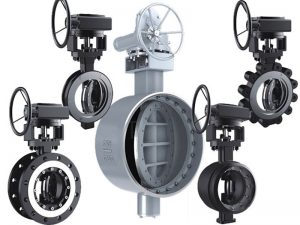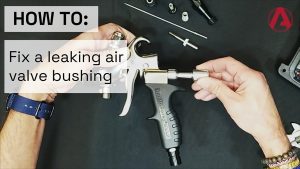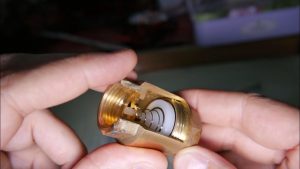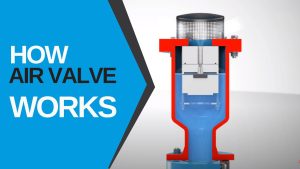Got a leaking Luftventil that’s driving you crazy?
So sieht es aus: How to fix a leaking Luftventil depends on what type of valve you’re dealing with and where the leak is coming from. But the good news? Most valve leaks can be fixed in under 10 minutes with basic tools.
I’ve fixed hundreds of leaking valves over the years. And in this guide, as a professional Luftventil manufacturer, I’ll show you exactly how to diagnose and repair any type of Luftventil leak – from tire valves to pneumatic systems.
Lassen Sie uns gleich eintauchen.

Inhaltsübersicht
What Causes Air Valves to Leak?
Before we jump into the fixes, you need to understand WHY valves leak in the first place.
In my experience, 90% of Luftventil leaks come from these issues:
Loose valve cores – The most common culprit. Valve cores can work themselves loose over time from vibration and temperature changes.
Damaged valve stems – Rubber valve stems deteriorate with age. UV exposure and weather can cause cracks at the base.
Dirty or corroded parts – Debris and corrosion prevent proper sealing. Even a tiny speck of dirt can cause a persistent leak.
Worn seals and gaskets – Internal seals wear out over time. This is especially common in pneumatic valves that see heavy use.
The bottom line? Most leaks are simple fixes that don’t require replacement of the entire valve assembly.
How to Fix a Leaking Air Valve
Step 1: Find the Exact Leak Location
You can’t fix what you can’t find.
So your first step is pinpointing exactly where the air is escaping from.
Here’s my go-to method:
The Soapy Water Test
Mix a few drops of dish soap with water in a spray bottle. (Pro tip: Dawn works best because it creates lasting bubbles.)
Spray the mixture liberally on:
- The valve tip
- Around the valve base
- Any visible connections
Watch for bubbles. Growing bubbles = air leak.
This method works for ANY type of Luftventil – tire valves, pneumatic fittings, compressed air systems, you name it.
Listen for the Leak
Sometimes you can actually hear air hissing out. Get close to the valve and listen carefully. The louder the hiss, the bigger the leak.
Place your hand near suspected areas. You’ll feel air flow if there’s a significant leak.
Step 2: Gather Your Tools
The tools you need depend on your valve type.
Für tire valves (most common), you’ll need:
- Valve core tool (4-way tool works great)
- Replacement valve cores
- Safety glasses
- Air pressure gauge
- Pump or compressor
Für pneumatische Ventile, add:
- Appropriate wrenches
- Thread sealant or Teflonband
- Replacement O-rings or gaskets
Here’s the thing: A basic valve core tool costs about $5 and can save you from expensive repairs. Every DIYer should have one.
Step 3: Fix a Loose or Dirty Valve Core
This is by far the easiest fix. And it solves most tire valve leaks.
First, try tightening the existing core:
- Remove the valve cap
- Insert your valve core tool
- Turn clockwise to tighten (snug, not overtight)
- Re-test with soapy water
Still leaking? Time to replace the core:
- Deflate completely – This is crucial for safety. A valve core can shoot out like a bullet under pressure.
- Unscrew the old core counterclockwise
- Inspect for damage or debris
- Install new core (hand-tight plus 1/4 turn)
- Reinflate and test
I’ve seen valve cores so corroded they looked like they’d been soaking in acid. When in doubt, just replace it. New cores cost pennies.
Step 4: Address Valve Stem Problems
If your leak is at the valve stem base (common on older tires), you’ve got a bigger issue.
Signs of valve stem failure:
- Cracks in the rubber
- Bubbles forming at the wheel/stem junction
- Stem moves when wiggled
Unfortunately, valve stem replacement usually requires tire removal. Here’s why:
The stem passes through the wheel from inside the tire. You need access to the inside to push out the old stem and pull in the new one.
That said, I’ve successfully used this temporary fix for minor stem leaks:
- Clean around the stem base thoroughly
- Apply rubber cement or valve stem sealant
- Let cure according to directions
- Monitor closely – this is temporary!
For permanent repair, visit a tire shop. They can replace the stem for $10-30 per tire.
Different Valve Types and Their Quirks
Not all air valves are created equal. Let me break down the most common types:
Schrader Valves
These are your standard tire valves – the ones on cars, bikes, and most pneumatic equipment.
Characteristics:
- Spring-loaded pin in center
- Removable valve core
- Very common and easy to service
Common issues:
- Loose cores (80% of problems)
- Damaged pin springs
- Corroded threads
Presta Valves
Found on high-end bicycles and some specialty applications.
Key differences:
- Thinner than Schrader
- Lock nut at top
- Some have non-removable cores
Besondere Überlegungen:
- Require Presta-specific tools
- More delicate than Schrader
- Lock nut must be opened before inflating
Pneumatic System Valves
Industrial and shop air systems use various valve types.
Common problems:
- Worn O-rings
- Damaged seat surfaces
- Contamination from moisture/oil
These often require disassembly and seal replacement rather than simple core swaps.
Advanced Troubleshooting
Sometimes the standard fixes don’t work. Here’s what to check next:
Persistent Core Leaks
If new cores keep leaking:
- Check the valve body threads – Use the tap end of your valve tool to clean internal threads
- Inspect for cracks – Hairline cracks in the valve body mean replacement time
- Try a different core brand – Quality varies significantly
Temperature-Related Leaks
Cold weather can cause:
- Seal shrinkage
- Increased leak rates
- Pressure drops even without leaks
Solution: Check and adjust pressure when temperatures are stable.
Contamination Issues
Oil, moisture, or debris in pneumatic systems causes ongoing problems.
Prevention is key:
- Use air dryers
- Install filters
- Drain moisture regularly
- Keep valve caps on
Wann Sie einen Fachmann hinzuziehen sollten
Look, I’m all for DIY repairs. But know your limits.
Call a pro when:
- Leak is in the wheel/rim junction
- Multiple fixes haven’t worked
- You’re dealing with TPMS sensors
- Industrial pneumatic systems beyond simple valves
A good tire shop can diagnose and fix most valve issues for less than $50. Sometimes that’s money well spent.
Cost Breakdown
Let’s talk money. Here’s what you can expect to pay in 2025:
DIY Repairs:
- Valve core tool: $5-15
- Replacement cores: $2-5 per pack
- Valve stems: $2-10 each
- Basic sealants: $5-10
Professional Service:
- Valve core replacement: $10-20
- Stem replacement: $15-50
- TPMS service: $30-80
- Pneumatic valve rebuild: $50-200
The math is clear: Learning basic valve repair pays for itself after one fix.
Maintenance Tips
Prevention beats repair every time.
Here’s how to avoid future leaks:
Check monthly – Include valve inspection in your routine pressure checks
Keep caps on – Valve caps aren’t just decorative. They keep debris out.
Replace proactively – Rubber stems should be replaced every 5-7 years or with new tires
Clean regularly – Wipe valve tips before connecting air chucks
Use quality parts – Cheap valve cores are false economy
Erfolgsgeschichte aus der Praxis
Last month, my neighbor knocked on my door. His truck tire was losing 5 PSI daily.
We did the soapy water test – massive bubbles at the valve tip. Classic loose core.
Two minutes with my valve tool: problem solved. He’d been driving to the gas station daily to add air. A 30-second fix saved him hours of hassle.
That’s the power of knowing basic valve repair.
Safety Reminders
Air pressure is no joke. Follow these rules:
- Wear safety glasses – Always. No exceptions.
- Deflate before core removal – Cores can become projectiles
- Check pressure ratings – Don’t exceed valve specifications
- Test after repairs – Verify fixes before hitting the road
Die Quintessenz
Lernen how to fix a leaking Luftventil is one of those skills that pays dividends forever.
Most leaks are simple fixes – loose cores, dirty threads, or worn seals. With basic tools and 10 minutes, you can solve 90% of valve problems yourself.
Start with the soapy water test. Try tightening or replacing the core. If that fails, evaluate whether you need professional help.
Remember: A leaking valve won’t fix itself. But now you know exactly how to fix it yourself.












